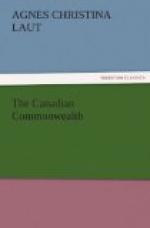And wheat is not the only product of the three prairie provinces. On the borderland between Manitoba and Saskatchewan are enormous deposits of coal which have not yet been explored. Canoeing once through Eastern Saskatchewan and Northern Manitoba, I saw a piece of almost pure copper brought down from the hinterland of Churchill River by an Indian, from an unknown mine, which no white man has yet found. On the borderland between Alberta and British Columbia is a ridge of coal deposits which such conservative experts as the late George Dawson estimated would mine four million tons a year for five thousand years. These coal deposits seem almost nature’s special provision for the treeless plains.
It is well known that the decrease in white fish in the Great Lakes for the past ten years has been appalling. Northward of Churchill River is a region of chains of lakes—the Lesser Great Lakes, they have been called—and these are the only untouched inland fisheries in America. To the exporter they are ideal fishing ground. The climate is cool. The fish can be sent out frozen to American markets. Of Canada’s thirty-four million dollars’ worth of fish in 1912, one and one-half million dollars’ worth came from the three prairie provinces.
Under the old boundaries, the three prairie provinces compared in area respectively Manitoba with Great Britain; Saskatchewan with France; Alberta, one and a half times larger than Germany. Under the new boundaries extending the province to Hudson Bay, Manitoba is fifty-two thousand square miles larger than Germany; Saskatchewan extended north is fifty thousand square miles larger than France; and Alberta extended north is fifty thousand square miles larger than Germany. And north of the three grain provinces is an area the size of European Russia.
We talk of Canada’s boom as “done,” but has it even begun? Strathcona used to say that the three prairie provinces would support a population of one hundred million. Was he right? On the basis of Europe’s population the three provinces would sustain three times Germany’s sixty-five millions.
VI
In British Columbia one reaches the province of the greatest natural wealth, the greatest diversity in climate and the most feverish activity in Canada. East of the mountains is a climate high, cold and bracing as Russia or Switzerland. Between the ranges of the mountains are valleys mild as France. On the coast toward the south is a climate like Italy; toward the north, like Scotland. Of Canada’s entire timber area—twice as great as Europe’s standing timber—three-quarters lie in British Columbia. Fruit equal to Niagara’s, fisheries richer than the maritime provinces, mines yielding more than Klondike—exist in this most favored of provinces. While the area is a half larger than Germany, the population is smaller than that of a suburb of Berlin.[12] Of Canada’s thirty-four million dollars’ worth of fish, thirteen million dollars’ worth come from British Columbia; and of her products of forty-six millions of precious and fifty-six millions of non-metallic minerals in 1911 easily half came from British Columbia.[13]




